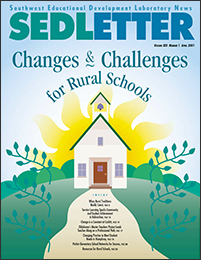Changing Practice to Meet Student Needs in Humphrey
 | |
| Members of the Humphrey Elementary School staff pictured clockwise beginning front left: school principal Iciphine Jones, third-grade teacher JoAnn Barron, second-grade teacher Rita Person, and kindergarten teacher Denice Houghton. | |
Three years ago in Humphrey, Arkansas (population 743), teachers were frustrated. For years they had been given new programs designed to improve student achievement but the district's test scores remained stagnant. At the same time, there was an increased push for accountability. The teachers in this delta school had few resources and were uncertain how to incorporate all of the state's mandates into their classrooms and improve student learning. "The teachers felt like they had a lot of little pieces, but they didn't know how to fit them together," explains former SEDL program associate Glenda Copeland. Teachers attended numerous training sessions designed to help them implement mandates and programs, but according to Humphrey third-grade teacher JoAnne Barron, "When you got inside your own little classroom and closed the door, you did things the way you wanted to do them." She adds, "At one time I just put the lesson plan out there and said, ÔHere it is, I'm teaching this today, get it.'" Barron admits that most of the time the only way students "got it" was by memorization.
Today those attitudes have changed, thanks to the leadership of Humphrey Elementary School principal Iciphine Jones, with assistance from the Southwest Educational Development Laboratory (SEDL). Because of Jones's desire to provide her teachers with training that would help them make better instructional choices and improve student outcomes, she agreed to let Humphrey Elementary School* become involved with SEDL's Promoting Instructional Coherence (PIC) project.
 | |
At the heart of PIC is an improvement process that includes the teachers' using inquiry, reflection, activities, and dialogue to examine their teaching and the beliefs and assumptions that underlie their practice, and to identify dilemmas, tensions, and inconsistencies within their practice. The process also includes collecting and using data to analyze student learning and to make instructional decisions that improve learning. As teachers begin to reflect on their practice, they discover that curriculum, instruction, and assessment are linked. Changing any one aspect impacts the others. Teachers learn to rethink what they teach and the kinds of experiences students must have to meet established standards. In short, engaging in the PIC process helps teachers understand how curriculum, instruction, and assessment and various mandates and programs mesh to ensure coherent instruction, all the while maintaining a focus on student learning.
SEDL's focus on student learning dovetails with Jones's philosophy. According to the educator with 23 years of teaching experience, there is only one way to raise test scores: "You have to shift the focus of teaching from teacher-centered classrooms to learner-centered classrooms."
During study group meetings, Humphrey's faculty identified assessment as a major issue. They recognized a lack of consistency in evaluation of student work. For example, a student might receive all As from her teacher one year in math, while the next year she would receive Cs. The grading experiences confused students and parents, and teachers were often unsure whether their students' work was of an appropriate quality for their grade level and age or whether their students were actually learning. The teachers realized that in order to implement state reforms and improve student outcomes, they would have to construct and apply consistent criteria for assessing student work across a student's K-8 experience.
As the teachers examined student work—first the work of students other than their own and then that of their students—they were able to identify what constitutes quality work. The group then clarified their expectations of quality and determined levels or stages of development toward that quality work. The teachers were eventually able to agree on a method to provide consistent grading from grade level to grade level, eliminating any surprise in grading policy from teacher-to-teacher. They were also better able to communicate clear expectations to students.
During the second phase of the project, which began in the fall of 1998, the group focused on how teachers could best use the Arkansas Curriculum Framework and results from the Stanford Achievement Test, Ninth Edition (SAT 9), to make instructional decisions to meet student needs.

Teacher attitudes changed during Humphrey's participation in PIC. Kindergarten teacher Denise Houghton credits the PIC process for changing how she views teaching. She says the process "doesn't allow you to be content with what you're doing."
Barron reports that when the project started, the teachers did not want to change. "But as we progressed," she says, "reading professional literature, looking at the research, and getting positive feedback, we saw that it would work. The project made me want to be a better teacher." Teachers regularly sit in on other classes, providing their colleagues with constructive criticism.
Second-grade teacher Rita Persons agrees. Initially, there were so many concepts and issues of which to make sense, she was overwhelmed. But Persons says the study group sessions have enabled teachers to find ways to ensure every student "walks out of Humphrey Elementary with a quality education."
Jones is proud of her teacher's progress. "Teachers are taking a closer look at the curriculum and test scores," she reports. "They are looking closely at what they've been doing within their classrooms, identifying what their students need." When the Arkansas Department of Education initiated Smart Start, its standards-based initiative, the teachers in tiny Humphrey were ready for the challenge. Jones told her staff, "You're already doing this. You don't have to worry."
"We are glad we already had the pieces in place," she says.
Pamela Porter is a freelance writer and photographer based in Las Cruces, New Mexico, who frequently contributes to SEDLetter.
Next Article: Network for Success

